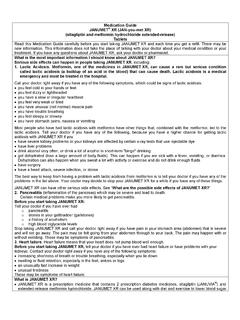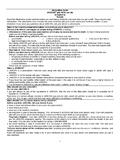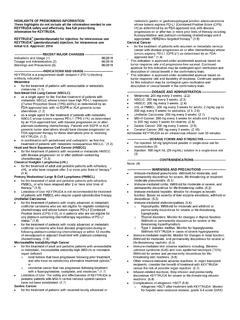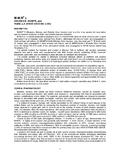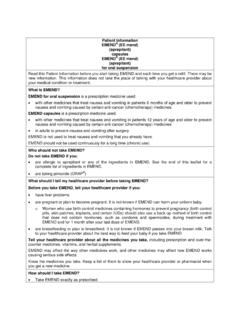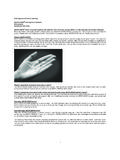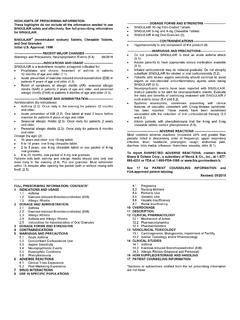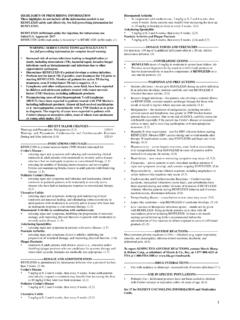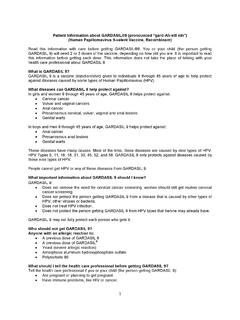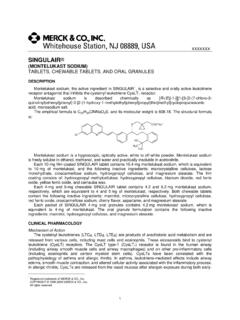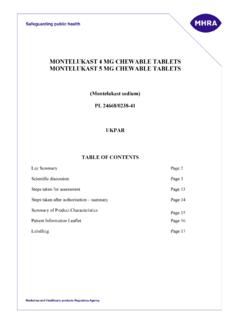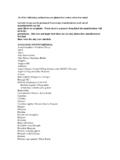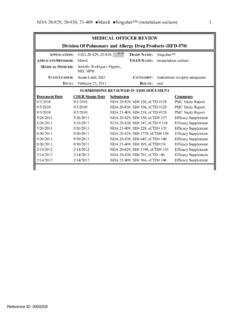Transcription of Proposed Prescribing Information (USPI) Singulair
1 HIGHLIGHTS OF Prescribing INFORMATIONT hese highlights do not include all the Information needed to use Singulair safely and effectively. See full Prescribing Information for (montelukastsodium) Tablets, chewable Tablets, and Oral GranulesInitial Approval:1998--------------------------- RECENT MAJOR CHANGES---------------------------Warnin gs and Precautions, Neuropsychiatric Events ( )09/2018----------------------------INDI CATIONS AND USAGE----------------------------SINGULA IRis aleukotriene receptor antagonist indicated for: Prophylaxis and chronic treatment of asthma in patients 12months of age and older( ). Acute prevention of exercise-induced bronchoconstriction (EIB) in patients 6 years of age and older ( ). Relief of symptoms of allergic rhinitis(AR): seasonal allergic rhinitis(SAR)in patients 2 years of age and older, and perennial allergic rhinitis(PAR)in patients 6 months of age and older ( ).
2 -----------------------DOSAGE AND ADMINISTRATION------------------------Ad ministration (by indications): Asthma ( ): Once daily in the eveningfor patients 12 months and older. Acute prevention of EIB ( ): Onetablet at least 2 hours before exercisefor patients 6 years of age and older. Seasonal allergic rhinitis ( ): Once dailyfor patients 2 years and older. Perennial allergic rhinitis ( ): Once dailyfor patients 6 months and (by age)(2): 15years and older: one 10-mg tablet. 6 to 14years: one 5-mg chewable tablet. 2 to 5 years: one 4-mg chewable tablet or one packet of 4-mg oral granules. 6 to 23months: one packet of 4-mg oral with both asthma and allergic rhinitis should take only one dose daily in the evening ( ). For oral granules: Must administer within 15 minutes after opening the packet (with or without mixing with food) ( ).---------------------DOSAGE FORMS AND STRENGTHS--------------------- SINGULAIR10-mg Film-CoatedTablets Singulair 5-mg and 4-mg chewable Tablets Singulair 4-mg Oral Granules(3)----------------------------- --CONTRAINDICATIONS--------------------- ---------- Hypersensitivity to any component of this product(4).
3 ------------------------WARNINGS AND PRECAUTIONS------------------------ Do not prescribe Singulair to treat an acute asthma attack( ). Advise patients to have appropriate rescue medication available( ). Inhaled corticosteroid may be reduced gradually. Do not abruptly substitute Singulair for inhaled or oral corticosteroids ( ). Patients with known aspirin sensitivity should continueto avoid aspirin or non-steroidal anti-inflammatory agents while taking Singulair ( ). Neuropsychiatric events have been reportedwith Singulair . Instruct patients to be alert for neuropsychiatric events. Evaluate the risks and benefits of continuing treatment with SINGULAIRif such events occur ( and ). Systemic eosinophilia, sometimes presenting with clinical features of vasculitis consistent with Churg-Strauss syndrome, has been reported. These events have been sometimes associated with the reduction of oral corticosteroid therapy( and ).
4 Inform patients with phenylketonuria that the 4-mg and 5-mg chewable tablets contain phenylalanine ( ).------------------------------ADVERSE REACTIONS------------------------------M ost common adverse reactions (incidence 5% and greater than placebo listed in descending order of frequency): upper respiratory infection, fever, headache, pharyngitis, cough, abdominal pain, diarrhea, otitis media, influenza, rhinorrhea, sinusitis, otitis ( ).To report SUSPECTED ADVERSE REACTIONS, contactMerck Sharp & Dohme Corp., a subsidiary of Merck & Co., Inc., at 1-877-888-4231or FDA at 1-800-FDA-1088 or 17 for PATIENT COUNSELING Information and FDA-approved patient : 09/2018 FULL Prescribing Information : CONTENTS*1 INDICATIONS AND Bronchoconstriction(EIB) Rhinitis2 DOSAGE AND Bronchoconstriction(EIB) Rhinitis Allergic for Administration of Oral Granules3 DOSAGE FORMS AND STRENGTHS4 CONTRAINDICATIONS5 WARNINGS AND Concomitant Corticosteroid ADVERSE Trials Experience7 DRUG INTERACTIONS8 USE IN SPECIFIC Insufficiency10 OVERDOSAGE11 DESCRIPTION12 CLINICAL of NONCLINICAL , Mutagenesis, Impairment of Toxicology and/or Pharmacology14 CLINICAL Bronchoconstriction(EIB) Rhinitis (Seasonal and Perennial) 16 HOW SUPPLIED/STORAGE AND HANDLING17 PATIENT COUNSELING Information *Sections or subsections omitted from the full Prescribing Information are not Prescribing INFORMATION1 INDICATIONS AND is indicated for the prophylaxis and chronic treatment of asthma in adults and pediatric patients 12months of age and Bronchoconstriction(EIB)
5 Singulair is indicated for prevention of exercise-induced bronchoconstriction(EIB)in patients 6 years of age and RhinitisSINGULAIR is indicated for the relief of symptoms of seasonal allergic rhinitis in patients 2 years of age and older and perennial allergic rhinitis in patients 6 months of age and AND AsthmaSINGULAIR should be taken once daily inthe evening. The following doses are recommended:For adults and adolescents 15years of age and older: one 10-mg pediatric patients 6 to 14years of age: one 5-mg chewable pediatric patients 2 to 5 years of age: one 4-mg chewable tablet or one packet of 4-mg oral pediatric patients 12to 23 months of age: one packet of 4-mg oral and effectiveness in pediatric patients less than 12months of age with asthma have not been have been noclinical trials in patients with asthma to evaluate the relative efficacy of morning versus evening dosing.
6 The pharmacokinetics of montelukast are similar whether dosed in the morning or evening. Efficacy has been demonstrated for asthma when montelukastwas administered in the evening without regard to time of food Exercise-Induced Bronchoconstriction (EIB)For prevention of EIB, a single dose of Singulair should be taken at least 2 hours before exercise. The following doses are recommended:For adults and adolescents 15years of age and older: one 10-mg pediatric patients 6 to 14years of age: one 5-mg chewable additional dose of Singulair should not be taken within 24 hours of a previous dose. Patients already taking Singulair daily for another indication (including chronic asthma) should not take an additional dose to prevent EIB. All patients should have available for rescue a short-acting -agonist. Safety and efficacyin patients younger than 6years of age have not been established. Daily administration of Singulair for the chronic treatment of asthma has not been established to prevent acute episodes of Allergic RhinitisFor allergic rhinitis, Singulair should be taken once daily.
7 Efficacy was demonstrated for seasonal allergic rhinitis when montelukast was administered in the morning or the evening without regard to time of food time of administration may be individualized to suit patient following doses for the treatment of symptoms of seasonal allergic rhinitis are recommended:For adults and adolescents 15years of age and older: one 10-mg pediatric patients 6 to 14years of age: one 5-mg chewable pediatric patients 2 to 5 years of age: one 4-mg chewable tablet or one packet of 4-mg oral and effectiveness in pediatric patients younger than 2 years of age with seasonal allergic rhinitis have not been following doses for the treatment of symptoms of perennial allergic rhinitis are recommended:For adults and adolescents 15years of age and older: one 10-mg pediatric patients 6 to 14years of age: one 5-mg chewable pediatric patients 2 to 5 years of age: one 4-mg chewable tablet or one packet of 4-mgoral pediatric patients 6 to 23 months of age: one packet of 4-mg oral and effectiveness in pediatric patients younger than 6 months of age with perennial allergic rhinitis have not been Asthma and Allergic RhinitisPatients with both asthma and allergic rhinitis should take only one Singulair dosedaily in the Instructions for Administration of Oral GranulesSINGULAIR 4-mg oral granules can be administered either directly in the mouth, dissolvedin 1 teaspoonful (5mL) of cold or room temperature baby formula or breast milk, or mixed with a spoonful of cold or room temperature soft foods; based on stability studies, only applesauce, carrots, rice, or ice cream should be used.
8 The packet should not be opened until ready to use. After opening the packet, the full dose (with or without mixing with baby formula, breast milk, or food) must be administered within 15minutes. If mixed with baby formula, breast milk, or food, Singulair oral granules must not be stored for future use. Discard any unused portion. Singulair oral granules are not intended to be dissolved in any liquid other than baby formula or breast milk for administration. However, liquids may be taken subsequent to administration. Singulair oral granules can be administered without regard to the time of FORMS AND STRENGTHS Singulair 10-mg Film-Coated Tablets are beige, rounded square-shaped tablets, with code MSD117 on one side and Singulair on the other. Singulair 5-mg chewable Tablets are pink, round, bi-convex-shaped tablets, with code MSD275on one side and Singulair on the other. Singulair 4-mg chewable Tablets are pink, oval, bi-convex-shaped tablets, with code MSD711on one side and Singulair on the other.
9 SINGULAIR4-mg Oral Granules are white granules with 500 mg net weight, packed in a child-resistant foil Hypersensitivity to any component of this AND AsthmaSINGULAIR is not indicated for use inthe reversal of bronchospasm in acute asthma attacks, including status should be advised to have appropriate rescue medication available. Therapy with Singulair can be continued during acute exacerbations of asthma. Patients who haveexacerbations of asthma after exercise should have available for rescue a short-acting inhaled Corticosteroid UseWhile the dose of inhaled corticosteroid may be reduced gradually under medical supervision, Singulair should not be abruptly substituted for inhaled or oral SensitivityPatients with known aspirin sensitivity should continue avoidance of aspirin or non-steroidal anti-inflammatory agents while taking Singulair . Although Singulair is effective in improving airway function in asthmatics with documented aspirin sensitivity, it has not been shown to truncate bronchoconstrictor response to aspirin and other non-steroidal anti-inflammatory drugs in aspirin-sensitive asthmatic patients [see Clinical Studies ( )].
10 EventsNeuropsychiatric events have been reported in adult, adolescent, and pediatric patients taking Singulair . Post-marketing reports with Singulair use include agitation, aggressive behavioror hostility, anxiousness, depression,disorientation, disturbance in attention, dream abnormalities,hallucinations, insomnia, irritability, memory impairment,obsessive-compulsive symptoms, restlessness, 4somnambulism, suicidal thinking and behavior (including suicide), tic, and tremor. The clinical details of some post-marketing reports involving Singulair appearconsistent with a drug-induced and prescribers should be alert for neuropsychiatric events. Patients should be instructed to notify their prescriberif these changes occur. Prescribers should carefullyevaluate the risks and benefits of continuing treatment with Singulair if such events occur [see Adverse Reactions ( )]. Eosinophilic ConditionsPatients with asthma on therapy with Singulair may present with systemic eosinophilia, sometimes presenting with clinical features of vasculitis consistent with Churg-Strauss syndrome, a condition which is often treated with systemic corticosteroid therapy.
